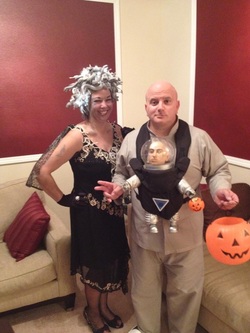 Team Members Eric & Jolyn O'Dierno
Team Members Eric & Jolyn O'Dierno The custom of guising at Halloween in North America is first recorded in 1911, where a newspaper in Kingston, Ontario reported children going "guising" around the neighborhood.
In 19th century America, Halloween was often celebrated with costume parades and "licentious revelries”. However, efforts were made to "domesticate" the festival to conform with Victorian era morality. Halloween was made into a private rather than public holiday, celebrations involving liquor and sensuality de-emphasized, and only children were expected to celebrate the festival. Early Halloween costumes emphasized the and gothic nature of Halloween, and were aimed primarily at children. Costumes were also made at home or using items (such as make-up) which could be purchased and utilized to create a costume. But in the 1930s, A.S. Fishbach, Ben Cooper, Inc., and other firms began mass-producing Halloween costumes for sale in stores as trick-or-treating became popular in North America. Halloween costumes are often designed to imitate supernatural and scary beings. Costumes are traditionally those of monsters such as vampires, werewolves, zombies, ghosts, skeletons, witches, goblins, trolls, devils, etc. or in more recent years such science fiction-inspired characters as aliens and superheroes. There are also costumes of pop culture figures like presidents, athletes, celebrities, or characters in film, television, literature, etc. Another popular trend is for women (and in some cases, men) to use Halloween as an excuse to wear sexy or revealing costumes, showing off more skin than would be socially acceptable otherwise. Young girls also often dress as entirely non-scary characters at Halloween, including princesses, fairies, angels, farm animals and flowers.
Halloween costume parties generally take place on or around October 31, often on the Friday or Saturday prior to the holiday.
**Credit to www.Wikipedia.org**

 RSS Feed
RSS Feed